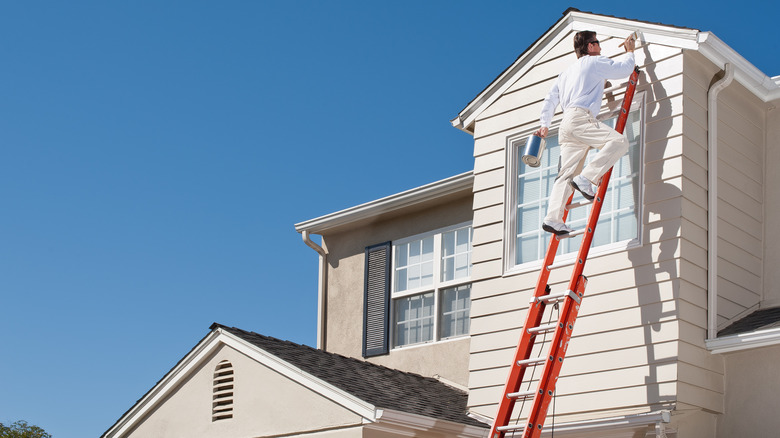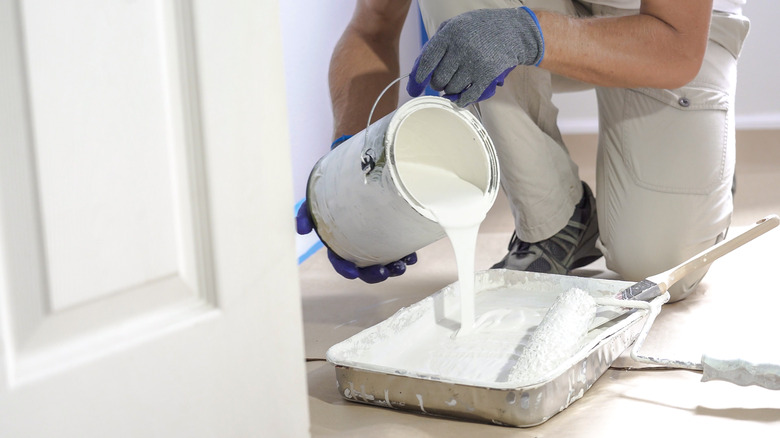Is It Really Worth Spending More Money To Buy Premium Paint?
The easiest, least expensive way to transform a room is a can of paint. Color can shout or whisper, but no matter what hue or intensity you prefer, a room can go from blah to beautiful in a single afternoon. Then there's the curb appeal of your house. Budgeting for both interiors and exteriors is important when estimating paint costs. Looking at the paint available in the market, the various brands, and the wide range of prices, we asked if premium paint is really worth the money. The answer is absolutely yes. And we'll explain why.
First, consider that paint is three things: pigment, thinner, and binder. Pigment is the color, but it's also the factor that determines how well the paint covers the wall. Thinners control the paint's consistency, which affects how easy or hard it is to apply. Watery paint runs all over, while better quality paint stays in place. Binders hold the paint together, affecting texture, appearance, and durability. Short of a chemistry lesson, just remember paint is usually referred to by its binder, latex (resin or polymers), or oil (alkyd).
Cheap vs. Premium Paint
So, what's the difference between cheap and premium paint? Cheap paint is thinner. It contains less pigment and binder and has more filler liquid. Premium paint has more pigment and binder. There's also a durability factor. Most painting jobs require a primer or base coat, followed by the main color. In the most challenging cases, rooms or walls need a second coat of the main color. This is especially the case when a surface is going from light to dark or dark to light. Counter-intuitively, light paint colors often need fewer coats than darker pigments because lighter colors have a thicker base. Darker colors have a thinner base, which creates the need for several coats.
We mentioned durability. Outside, this refers to climate and building materials. Color in sun-drenched, arid, or tropical climates will fade, and cheap paint will fade faster than premium paint due to its chemical makeup. Inside, durability refers to where the paint is going — a high-traffic area or a quiet nook. With kids and dogs inside a house, for example, chances are there will be more scuffs and marks along the walls. Premium paint can withstand the constant washing required, while a wall covered in cheap paint will have to be repainted sooner.
Paint value and your time
First, decide if you want to work with oil or latex paint. Both types have their charms and drawbacks. Latex paint is easy to apply, giving walls a rich, even finish. It dries quickly, and cleanup is a breeze, usually just requiring warm water. However, oil paint truly saturates surfaces and is often used for wood trim and metal pieces. While the finish is often luxuriously silky, oil paint often takes a long time to dry, which makes painting jobs last longer. Worse, oil paints outgas. This means they emit odors as well as VOCs — volatile organic compounds — that are not good for interior air quality.
The other thing to think about is your time. If you're in a rental, landlord permitting, you may want to work on a new coat of paint without spending a lot of money. In a starter or transition house, it's up to you whether or not you want to spend the money on premium paint. But you're the one who will live with the results for a few years. If you're working on your forever home, spending a few extra dollars on premium paint is an advantage because you won't have to paint that surface over and over. By using a higher-priced paint, you're paying for durability, so the higher cost of better paint is spread over many more years.


